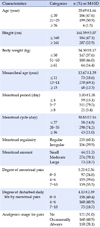1. Klein JR, Litt IF. Epidemiology of adolescent dysmenorrhea. Pediatrics. 1981; 68(5):661–664.

2. Dennerstein L, Lehert P, Heinemann K. Epidemiology of premenstrual symptoms and disorders. Menopause International. 2012; 18(2):48–51. DOI:
10.1258/mi.2012.012013.

3. Harlow SD, Campbell OMR. Epidemiology of menstrual disorders in developing counties: A systemic review. BJOG: An International Journal of Obstetrics and Gynaecology. 2004; 111(1):6–16. DOI:
10.1111/j.1471-0528.2004.00012.x.
4. Harel Z. Dysmenorrhea in adolescents and young adults: Etiology and management. Journal of Pediatric and Adolescent Gynecology. 2006; 19(6):363–371. DOI:
10.1016/j.jpag.2006.09.001.

5. Negriff S, Dorn LD, Hillman JB, Huang B. The measurement of menstrual symptoms: Factor structure of the menstrual symptom questionnaire in adolescent girls. Journal of Health Psychology. 2009; 14(7):899–908. DOI:
10.1177/1359105309340995.
6. Stubbs ML. Cultural perceptions and practices around menarche and adolescent menstruation in the United States. Annals of the New York Academy of Sciences. 2008; 1135(1):58–66. DOI:
10.1196/annals.1429.008.

7. Moos RH. The development of a menstrual distress questionnaire. Psychosomatic Medicine. 1968; 30(6):853–867.

8. Chesney MA, Tasto DL. The development of the menstrual symptom questionnaire. Behaviour Research and Therapy. 1975; 13(4):237–244.

9. Mitchell ES, Woods NF, Lenz MJ. Differentiation of women with three perimenstrual symptom patterns. Nursing Research. 1994; 43(1):25–30. DOI:
10.1097/00006199-199401000-00005.
10. Balbi C, Musone R, Menditto A, Di Prisco L, Cassese E, D'Ajello M, et al. Influence of menstrual factors and dietary habits on menstrual pain in adolescence age. European Journal of Obstetrics & Gynecology and Reproductive Biology. 2000; 91(2):143–148. DOI:
10.1016/S0301-2115(99)00277-8.

11. Daley AJ. Exercise and primary dysmenorrhea: A comprehensive and critical review of the literature. Sports Medicine. 2008; 38(8):659–670.
12. Costello AB, Osborne JW. Best practices in exploratory factor analysis: Four recommendations for getting the most from your analysis. Pract Assess Res Eval. 2005; 10(7):1–9.
13. Ju H, Jones M, Mishra GD. Premenstrual syndrome and dysmenorrhea: Symptom trajectories over 13 years in young adults. Maturitas. 2014; 78(2):99–105. DOI:
10.1016/j.maturitas.2014.03.008.

14. Abraham GE. Nutritional factors in the etiology of the premenstrual tension syndromes. The Journal of Reproductive Medicine. 1983; 28:446–464.
15. Warren JW, Howard FM, Cross RK, Good JL, Weissman MM, Wesselmann U, et al. Antecedent nonbladder syndromes in case-control study of interstitial cystitis/painful bladder syndrome. Urology. 2009; 73(1):52–57. DOI:
10.1016/j.urology.2008.06.031.

16. Tu FF, Epstein AE, Pozolo KE, Sexon DL, Melnyk AI, Hellman KM. A non-invasive bladder sensory test supports a role for dysmenorrhea increasing bladder noxious mechanosensitivity. Clin J Pain. 2013; 29(10):833–890. DOI:
10.1097/AJP.0b013e31827a71a3.

17. Hellman KM, Datta A, Steiner ND, Morlock JNK, Garrison EF, Clauw DJ, et al. Identification of experimental bladder sensitivity among dysmenorrhea suffers. American Journal of Obstetrics & Gynecology. 2018; 219:84.e1–84.e8. DOI:
10.1016/j.ajog.2018.04.030.
18. Jun EM. A study on menstrual symptoms, coping and relief of symptoms in female college students. Korean J Women Health Nurs. 2003; 9(2):161–169.

19. Noh YG, Lee YS. Relationship between life style, menstrual distress and coping method in nursing students. J Korea Acad Ind Coop Soc. 2015; 16(2):1118–1128. DOI:
10.5762/KAIS.2015.16.2.1118.

21. Davis AR, Westhoff CL. Primary dysmenorrhea in adolescent girls and treatment with oral contraceptives. Journal of Pediatric and Adolescent Gynecology. 2001; 14(1):3–8. DOI:
10.1016/S1083-3188(00)00076-0.

22. Soe HHK, Than NN, Lwin H, Htay MNN, Phyu KL, Moe S. Premenstrual symptoms and dysmenorrhea associated with daily routine activities among female undergraduate medical students. Br J Med Med Res. 2017; 21(2):1–9. DOI:
10.9734/BJMMR/2017/33493.

23. Parker MA, Sneddon AE, Arbon P. The menstrual disorder of teenagers (MDOT) study: Determining typical menstrual patterns and menstrual disturbance in a large population-based study of Australian teenagers. BJOG: An International Journal of Obstetrics and Gynaecology. 2010; 117(2):185–192. DOI:
10.1111/j.1471-0528.2009.02407.x.

24. Meaden PM, Hartlage SA, Cook-Karr J. Timing and severity of symptoms associated with the menstrual cycle in a community-based sample in the Midwestern United States. Psychiatry Research. 2005; 134(1):27–36.

25. Romans S, Clarkson R, Einstein G, Petrovic M, Stewart D. Mood and the menstrual cycle: A review of prospective data studies. Gender Medicine. 2012; 9(5):361–384. DOI:
10.1016/j.genm.2012.07.003.

26. Brahmhatt S, Sattigeri BM, Shah H, Kumar A, Parikh D. A prospective survey study on premenstrual syndrome in young and middle aged women wit an emphasis on its management. Int J Res Med Sci. 2013; 1(2):69–72. DOI:
10.5455/2320-6012.ijrms20130506.
28. Pandian VM, Priyan SS, Vaik AF, Oumanath F. Premenstrual symptoms: Prevalence, coping behaviors and related quality of life. Int J Interdiscip Multidiscip Stud. 2016; 3(3):27–33.











 PDF
PDF ePub
ePub Citation
Citation Print
Print





 XML Download
XML Download